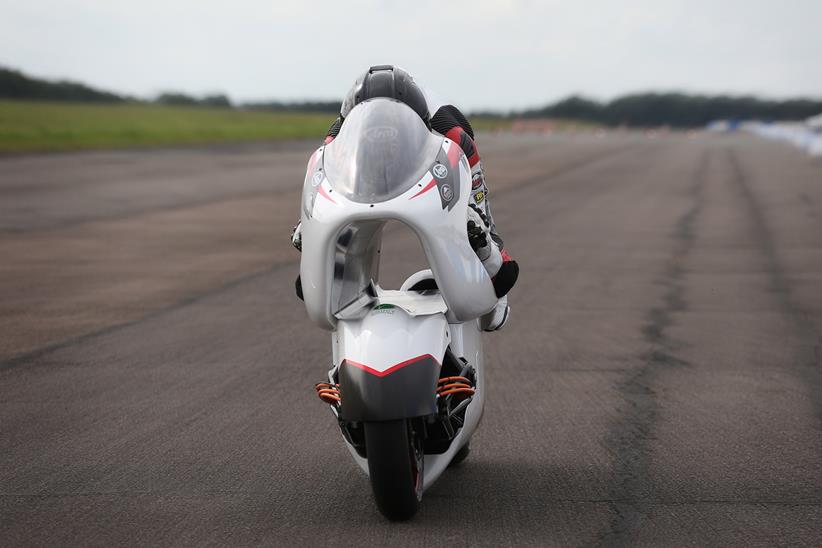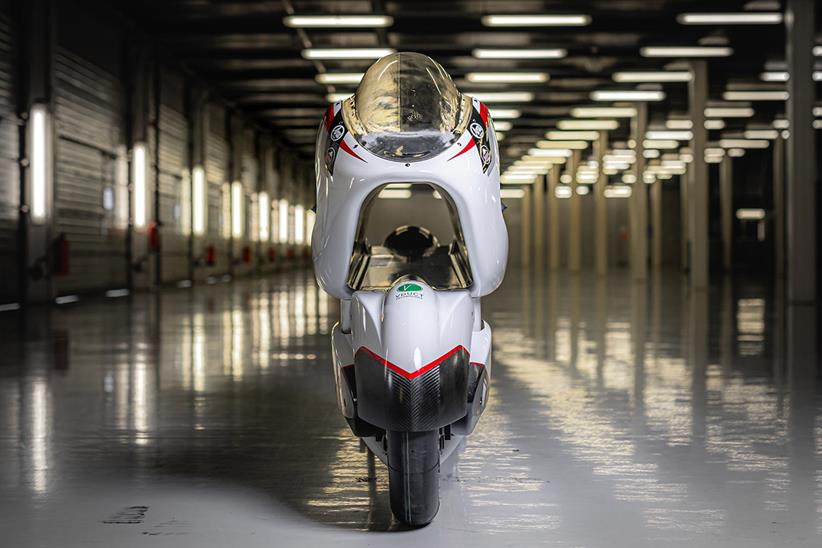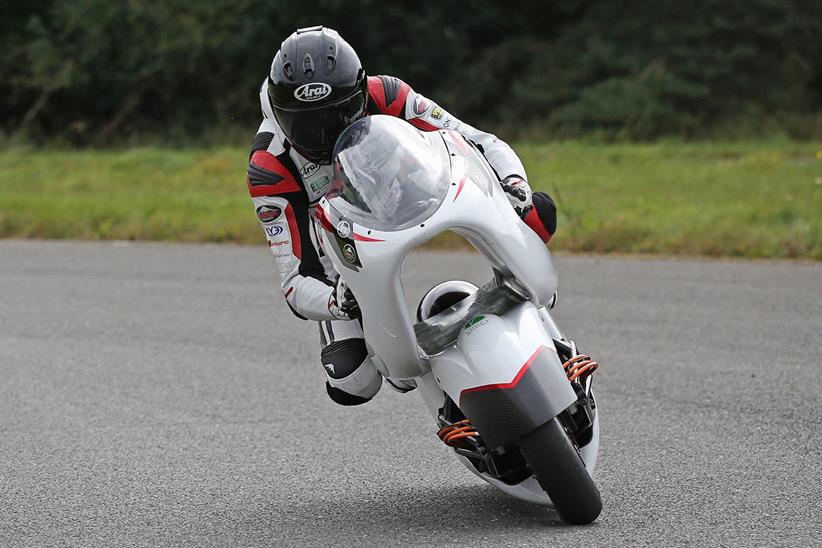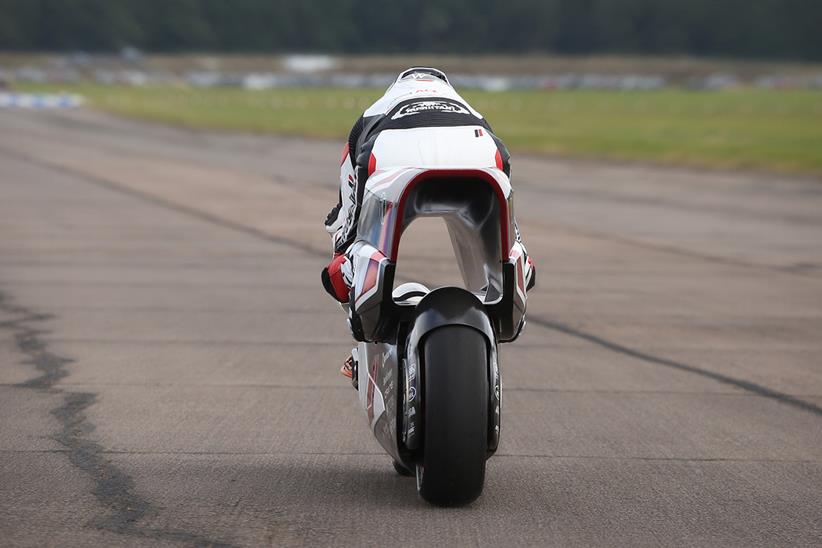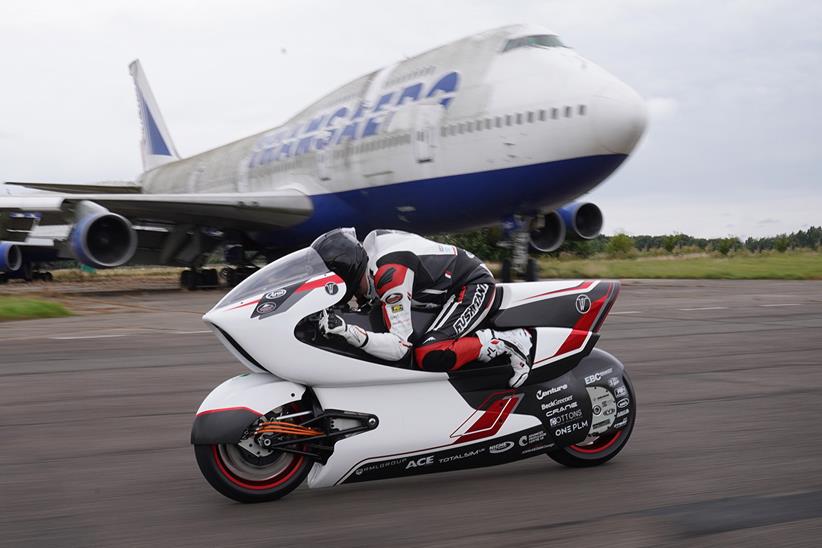Holy moly! Mad-looking British speed machine hits the track in high-speed testing
The outlandish Brit bike that’s targeting the speed record for electric motorcycles has hit the track as it undergoes initial test runs in the UK.
Related articles on MCN
- Max Biaggi claims 11 speed records on Voxan Wattman
- Guy Martin aiming for 400mph streamliner record
- Best electric bikes of 2021
White Motorcycle Concepts unveiled the WMC250EV back in June, bringing a host of new ideas to the table centred around a vast aerodynamic duct that slashes the bike’s frontal area and drag coefficient without resorting to the sort of low-slung, extended-wheelbase semi-streamliner setup which is more common on record-setters.
That means it’s an idea which could be transferred to road bikes, since the seat height and fairing silhouette could allow for a conventional riding position.
![]()
The aero also reduces front-end lift, allowing the use of two-wheel-drive – with two electric motors mounted in the front hub, along with another pair driving the rear wheel via an enclosed chain – to maximise traction, which can be a problem on the slippery salt flats where the record will be attempted.
Computer modelling and wind tunnel tests showed a 70% reduction in drag compared to the best conventional road bikes, but it’s only in real-world action that those numbers can be verified, so the WMC250EV’s shake-down tests on home turf were an important step to proving the aerodynamic idea as well as confirming that the electric drivetrain is working as planned.
Initially, the bike has been put through its paces using a 100kW powertrain (equivalent to 137bhp), but the final version will have around 250kW on tap (335bhp). Even with less than half its power available, the team were pleased with the results.
![]()
The bike has already been running at around 170mph. As the bike’s name suggests, the eventual target is to take the world record to 250mph or beyond. It’s currently held by ex-GP and WSB star Max Biaggi on the Voxan Wattman at 228.05mph.
Rob White, who’s both designer and rider of the WMC250EV, said: “I am delighted with the progress that we have made and the high level of interest that the project has attracted. This is a bespoke motorcycle and for it to run straight out of the box is fantastic. My confidence that we will be successful is building all the time.”
Watch a video of the WMC250EV in action here:
Ace in the hole: How a massive central duct hopes to transform motorcycle aerodynamics
![]()
When Max Biaggi set the land speed record for electric bikes in the semi-streamlined class on Voxan’s Wattman last year he used brute power to achieve it – with 367hp on tap to average 228mph. Now British firm White Motorcycle Concepts plan to beat that record using clever aerodynamics and two-wheel drive.
The company’s confection of carbon-fibre and billet aluminium is the first demonstrator of a new aerodynamic concept, the brainchild of founder and namesake Robert White, an engineer with a quarter of a century’s experience in motorsport.
He will also ride the bike in the record attempt, but his plans are much more ambitious than simply going fast. He believes the same thinking that makes the WMC250EV 70% more aerodynamic than a Suzuki Hayabusa can be transferred to road bikes, working at sensible speeds to offer a boost in range, performance and economy that’s likely to be particularly useful for electric motorcycles.
![]()
The bike’s most obvious party piece is the duct running from nose – normally the place where aerodynamic pressure is highest on a conventional bike – right through to the tail. As well as reducing the bike’s frontal area, a key part of aerodynamic drag, it lowers the centre of pressure at the front, so the 200mph-plus airflow isn’t trying to lift the front wheel off the ground as much as on a conventionally designed bike.
The design means there’s more load over the front tyre at speed, allowing White’s second innovation – 2wd – to come into play. Instead of relying purely on the rear tyre’s grip to overcome aerodynamic drag on the Bolivian salt flats where the record attempt will be made, the WMC250EV uses both wheels. That adds traction, and when it comes to setting land speed records that’s as important as outright power.
The front wheel’s drive comes from two hub-mounted motors. Another two drive the rear wheel, mounted at the front of the swingarm and transmitting drive via an enclosed chain drive. Initially, the bike uses brushless motors from Hacker, a German firm that specialises in lightweight, high-powered motors for large radio-controlled aircraft.
The rear pair make 40bhp each, the front two are each good for 27bhp, giving a total of 134bhp for the bike’s initial form. That figure will rise as the record attempt gets closer. White reckons the existing set-up should be enough to raise the British record north of 200mph later this year but wants to hike power to over 250kW (335bhp) for the world record runs next year, aiming for in excess of 250mph.
![]()
Although the WMC250EV is a pure record-setter, White sees a future for both his 2wd system and the radical aerodynamics in production bikes. The conventional seat height means the ducted design could be used in a street bike, maintaining the high centre of gravity needed for cornering as well as a real-world riding position.
Plus, the 2wd system opens the door to an energy recovery system that recharges the batteries as you brake, something that’s lacking on current electric bikes that only power the rear wheel.
White Motorcycle Concepts WMC250EV explored:
- The hole truth CFD and full-sized wind tunnel tests confirm the bike’s drag is 70% lower than a Suzuki Hayabusa’s thanks to the central duct – made of carbon- fibre and supporting the rider’s seat and the bars.
- Two wheel drive A motor on either side of the purpose-built Dymag front wheel drives it directly. Hacker’s motors are relatively low revving, eliminating the need for a reduction gearbox. HEL calipers and EBC brake discs are also fitted.
- Cable operated steering A steering stem would block the aero intake, so the WMC250EV’s front wheel, mounted on a Bimota Tesi-style front swingarm, is steered via flexible cables routed either side of the duct.
- Sealed chain drive The rear motors drive an enclosed chain, which allows White to use thin oil, sprayed onto the chain to both lubricate and cool it during speed runs, without it being flung out onto the wheel and tyre. White also sees potential for the system on road bikes, with lower power losses and reduced maintenance compared to exposed chains.
- Battery in the chassis The entire lower section of the bike is of billet aluminium construction, used to mount the lithium-ion batteries and form the bike’s main structural frame section.
White Motorcycle Concepts WMC250EV targets 250mph with radical low drag design
First published on 23 June 2021 by Ben Purvis
![]()
A new British company from the motorsports heartlands of Northamptonshire has revealed the radical new machine to attempt both British and world electric land speed records over the next year.
Rob White, founder and driving force behind White Motorcycle Concepts, has been working on the WMC250EV for more than two years, creating a bike with ground-breaking aerodynamics and two-wheel-drive that’s already managed to attract considerable funding and support.
The bike breaks with conventional speed-record machines, which sit the rider as low as possible for aerodynamic gains, by sticking to a conventional seat height but adding a vast duct, dubbed ‘V-Air’ that runs straight through the bike. Testing, both in simulators and MIRA’s wind tunnel, has shown the design to reduce wind resistance by 70% compared to the most aerodynamic production bikes.
![]()
It also reduces front-end lift, allowing the firm to drive the front wheel as well as the rear to maximise traction, while a third innovation – called ‘F-Drive’ – features a fully-enclosed chain drive inside the swingarm that improves efficiency over a conventional design.
The WMC250EV name reflects the intention to go beyond 250mph, shattering the 228mph record set by Max Biaggi on the Voxan Wattman last year. Initially, the firm is targeting 200mph and a British record later this year using four electric motors – two powering the back wheel and another pair in the front hub – with a total of 100kW (134hp). That power will then be increased for the world record attempt in Bolivia in 2022.
“If you want to demonstrate to the rest of the world that you’ve just invented a new aerodynamic concept that means you can go faster for a given power, the best thing to do is go as fast you can,” says White. “That’s why we created WMC250EV high-speed demonstrator, the most radical version of this concept, to challenge for the world land speed record.”
He believes the same thinking can still provide significant benefits when toned-down for road-going bikes, saying: “While this technology allows you to go faster, it also allows you to go much further for the same amount of energy. This has a direct and tangible benefit on C02 reduction.”
The firm’s next project, a 300cc three-wheeled scooter based on the Yamaha Tricity 300, illustrates the idea’s potential at the other end of the performance envelope, with a 25% drag reduction and adds a hybrid system to the existing combustion engine to offer 500cc performance and 50% less CO2 emissions.
Check out a video about Rob White and the project here:
White noise: Tech secrets of bold British attempt to smash electric bike record
First published on 16 June 2021 by Ben Purvis
![]()
A new British challenger to the electric land speed record for motorcycles will be officially unveiled next week at Silverstone.
Related articles on MCN
- Max Biaggi claims 11 speed records on Voxan Wattman
- Randy Mamola rides special Indian sprint racer
- Best electric bikes of 2021
Created by Northants-based White Motorcycle Concepts, the WMC250EV promises radical aerodynamic and electric drive solutions, using the land speed record to prove their efficiency.
So far, the firm have revealed only snatched glimpses of the machine but they have high hopes that their ideas will be able to translate to improving mass-market electrics.
While the full reveal isn’t due until June 23, White Motorcycle Concepts say the bike incorporates three key technologies, dubbed ‘V-Air’, ‘D-Drive’ and ‘F-Drive’.
![]()
They’re intended to help it beat the record for a semi-streamlined electric motorcycle, set at 366.94km/h (228.05mph) by Max Biaggi on the Voxan Wattman last October, but also to have applications beyond that.
Founder and CEO, Robert White – an engineer with 24 years’ experience in the motorsports industry – will ride the bike, and is aiming to secure the British speed record later this year and then the world record in 2022.
The ‘V-Air’ aerodynamic innovation is said to reduce drag by an astounding 69%. In the process, the system also increases downforce and stability, and while the speed record machine will be an extreme interpretation of the idea, White believes it can be incorporated into mainstream machines in the future.
![]()
‘D-Drive’, the second piece of the puzzle, adds drive to the front wheel as well as the rear. By adding front drive, the door is also opened to effective regenerative braking, something that’s been absent from electric motorcycles so far because the front wheel – responsible for most of the braking – isn’t usually connected to the drivetrain.
The third still-secret tech, ‘F-Drive’, relates to the final drive. White Motorcycle Concepts say it enhances the efficiency of the final drive and could also be retro-fitted to existing motorcycles.
White said: “This is the culmination of two years’ hard work and I am very excited to finally be able to share these truly market disrupting innovations.”
A second project, dubbed WMC300FR, is being developed around the firm’s V-Air technology to demonstrate the idea’s feasibility at lower speeds on a city-oriented, road-going machine, with Yamaha’s Tricity 300 three-wheeled scooter as the benchmark.
